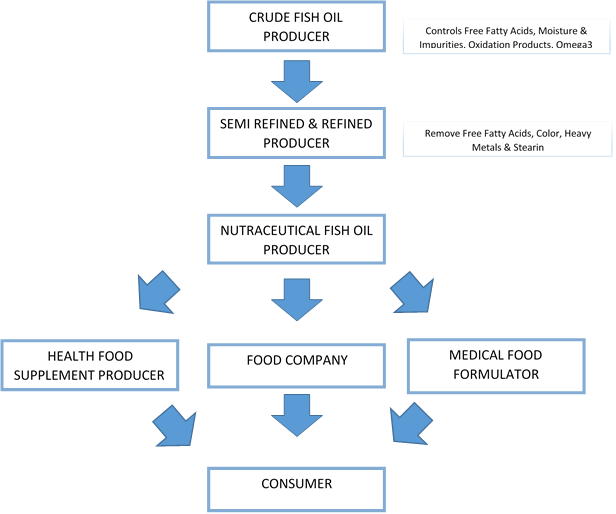The fish oil market includes fish oil obtained from fishing as well as aquaculture. The primary uses of fish oil are mainly for aquaculture, direct human consumption (DHC) and industrial uses. Peru, Chile and Denmark are the leading producers of fish oil and account for over 50% of global production. China is the known API (Active Pharmaceutical Ingredients) producer which captures nearly 60% of the world market. In terms of consumption, the European region is the largest consumer, primarily due to the farming of salmon and trout.
The demand for fish oil is expected to increase owing to the increased demand for omega-3 ingredients. Fish oil is the primary source of omega-3 and with the growing awareness of omega-3 and its benefits, consumers are increasing their intake of omega-3 as part of their regular diets. The global market for omega-3 is expected to reach USD 7.32 billion by 2020, according to a new study by Grand View Research, Inc. Growing consumer awareness regarding the health benefits associated with omega-3 coupled with rising prevalence of coronary heart diseases are expected to drive market demand over the next five years.
In addition, growing demand from emerging applications such as infant formulas and pharmaceuticals will further boost the growth of the market over the next five years. Raw material procurement, consumer perception with regards to fish oil and its smell, and the lack of standardisation in terms of labelling and registration, are expected to be key challenges for market participants in the near future.
Functional foods were the largest application segment of omega-3 ingredients in 2013, accounting for over 55% of the global demand. Infant formulas and pharmaceuticals were other key applications of omega-3 and are expected to have a combined market of over 2.7 billion by 2020, growing at a CAGR of 16.9 % and 17.5% from 2014 to 2020, respectively. Increasing R&D in encapsulation technology offers the market with growth opportunities over the next six years.
Supplements and functional foods were the largest application segment for the market with a share of over 55% and consuming close to 12.8 kilo tons of omega 3 ingredients in 2012. Pharmaceutical and Infant formulas were the other large application segments in the market together accounting for 33% of the global revenue. Consumption of omega 3 ingredients in infant formula is expected to be the fastest growing segment over the forecast period with an estimated CAGR of 15.3% from 2014 to 2020. The infant formula market is the world’s fastest-growing packaged food category, primarily due to the development of markets in Asia (particularly China) and Eastern Europe, and to a lesser extent in the Middle East and Latin America. Market development is linked with the economic growth of those countries and the growing number of working women who want premium products and the convenience of infant formula. The need for infant formula enrichment with DHA and ARA for non-breast-fed infants has been recognized by various official bodies including the United Nations FAO/WHO (Food and Agriculture Organization/World Health Organization), which recommends that all infant formula should contain DHA and ARA. An estimated 87% of infant formula sold in 2011 was fortified with DHA and ARA.

Malayan Fish Oil focuses on two main markets within the industry, the asian and european market. The company can handle the demand for the current needs. Our goal is to eventually have approximately 40% market share of the export to the european market since the europeans are focusing on outsourcing their manufacturing activities to other asian countries. Moreover, Malaysia is being widely recognised as the leading hub in the world for Halal foodstuff, which will serve as a key strategic advantage of having the refinery in Malaysia.